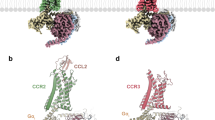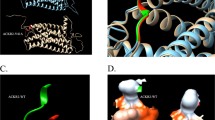Abstract
Chemokines are small secreted proteins that stimulate the directional migration of leukocytes and mediate inflammation1,2,3,4. During screening of a murine choroid plexus complementary DNA library, we identified a new chemokine, designated neurotactin. Unlike other chemokines, neurotactin has a unique cysteine pattern, Cys-X-X-X-Cys, and is predicted to be a type 1 membrane protein. Full-length recombinant neurotactin is localized on the surface of transfected 293 cells. Recombinant neurotactin containing the chemokine domain is chemotactic for neutrophils both in vitro and in vivo. Neurotactin messenger RNA is predominantly expressed in normal murine brain and its protein expression in activated brain microglia is upregulated in mice with experimental autoimmune encephalomyelitis, as well as in mice treated with lipopolysaccharide. Distinct from all other chemokine genes, the neurotactin gene is localized to human chromosome 16q. Consequently we propose that neurotactin represents a new δ-chemokine family and that it may play a role in brain inflammation processes.
This is a preview of subscription content, access via your institution
Access options
Subscribe to this journal
Receive 51 print issues and online access
$199.00 per year
only $3.90 per issue
Buy this article
- Purchase on Springer Link
- Instant access to full article PDF
Prices may be subject to local taxes which are calculated during checkout







Similar content being viewed by others
References
Oppenheim, J. J., Zachariae, C. O. C., Mukaida, N. & Mursushima, K. Properties of the novel proinflammatory supergene “intercrine” cytokine family. Annu. Rev. Immunol. 9, 617–648 (1991).
Baggiolini, M. & Dahinden, C. A. CC chemokines in allergic inflammation Immunol. Today 15, 127–133 (1994).
Baggiolini, M., Dewald, B. & Moser, B. Interleukin-8 and related chemotactic cytokines-CXC and CC chemokines. Adv. Immunol. 55, 97–197 (1994).
Schall, T. J. & Bacon, K. B. Chemokines, leukocyte trafficking, and inflammation. Curr. Opin. Immunol. 6, 865–873 (1994).
Kelner, G. S. et al. Lymphotactin: a cytokine that represents a new class of chemokine Science 266, 1395–1399 (1994).
Kennedy, J. et al. Molecular cloning and functional characterization of human lymphotactin. J. Immunol. 155, 203–209 (1995).
Yoshida, T., Imai, T., Kakizaki, M., Nishimura, M. & Yoshie, O. Molecular cloning of a novel C or g type chemokine, SCM-1. FEBS Lett. 360, 155–159 (1995).
Tartaglia, L. A. et al. Identification and expression cloning of a leptin receptor, OB-R. Cell 83, 1263–1271 (1995).
Moser, B., Clark-Lewis, I., Awahlen, R. & Baggiolini, M. Neutrophil-activating properties of the melanoma growth-stimulatory activity. J. Exp. Med. 171, 1797–1802 (1990).
Gehrmann, J., Matsumoto, Y. & Kreutxberg, G. W. Microglia: intrinsic immunoeffector cell of the brain. Brain Res. Rev. 20, 269–278 (1995).
Lafaille, J. J., Nagashima, K., Katsuki, M. & Tonegawa, A. High incidence of spontaneous autoimmune encephalomyelitis in immunodeficient auto-myelin basic protein T cell receptor transgenic mice. Cell 78, 399–408 (1994).
Witt, D. P. & Lander, A. D. Differential binding of chemokines to glycosaminoglycan subpopulations. Curr. Biol. 4, 394–400 (1994).
Massague, J. & Pandiella, A. Membrane-anchored growth factors. Annu. Rev. Biochem. 62, 515–541 (1993).
Flanagan, J. G., Chan, D. C. & Leder, P. Transmembrane form of the kit ligand growth factor is determined by alternative splicing and is missing in the Sld mutant. Cell 64, 1025–1035 (1991).
Brannan, C. I. et al. Steel-Dickie mutation encodes a c-kit ligand lacking transmembrane and cytoplasmic domains. Proc. Natl Acad. Sci. USA 88, 4671–4674 (1991).
Baldwin, E. T. et al. Crystal structure of interleukin 8: symbiosis of NMR and crystallography. Proc. Natl Acad. Sci. USA 88, 502–506 (1991).
Hebert, C. A., Vitangcol, R. V. & Baker, J. B. Scanning mutagenesis of interleukin-8 identifies a cluster of residues required for receptor binding. J. Biol. Chem. 266, 18989–18994 (1991).
Clark-Lewis, I., Schumacher, C., Baggiolini, M. & Moser, B. Structure-activity relationships of interleukin-8 determined using chemically synthesized analogs. Critical role of NH2-terminal residues and evidence for uncoupling of neutrophil chemotaxis, exocytosis, and receptor binding activities. J. Biol. Chem. 266, 23128–23134 (1991).
Hosaka, M. et al. Arg-X-Lys/Arg-Arg motif as a signal for precursor cleavage catalyzed by furin within the constitutive secretory pathway. J. Biol. Chem. 266, 12127–12130 (1991).
Bosenberg, M., Pandiella, A. & Massague, J. The cytoplasmic carboxy-terminal amino acid specifies cleage of membrane TGFα into soluble growth factor. Cell 71, 1157–1165 (1992).
Kochanek, P. M. & Hallenbeck, J. M. Polymorphonuclear leukocytes and monocytes/Macrophages in the pathogenesis of cerebral ischemia and stroke. Stroke 23, 1367–1379 (1992).
Altschul, S. F., Gish, W., Miller, W., Myers, E. W. & Lipman, D. J. Basic local alignment search tool. J. Mol. Biol. 215, 403–410 (1990).
Gish, W. & States, D. J. Identification of protein coding regions by database similarity search. Nature Genet. 3, 266–272 (1993).
von Heijne, G. Anew method for predicting signal sequence cleavage sites. Nucleic Acids Res. 14, 4683–4690 (1986).
Chirgwin, J. M., Przbyla, A. E., MacDonald, R. J. & Rutter, W. J. Isolation of biologically active ribonucleic acid from sources enriched in ribonuclease. Biochemistry 5294–5299 (1979).
Falk, W., Goodwin, R. H. J. & Leonard, E. J. A48-well micro chemotaxis assembly for rapid and accurate measurement of leukocyte migration. J. Immunol. Methods 33, ((1980)).
Larson, C. G., Anderson, A. O., Appella, E., Oppenheim, J. J. & Matsushima, K. The neutrophil-activating protein (NAP-1) is also chemotactic for T lymphocytes. Science 243, 1464–1466 (1989).
Nelson, R. M., Dolich, S., Aruffo, A., Cecconi, O. & Devilacqua, M. P. Higher-affinity oligosaccharide ligands for E-selectin. J. Clin. Invest. 19, 1157–1166 (1993).
Cowen, D. S., Lazarus, H. M., Shurin, S. B., Stoll, S. E. & Dubyak, G. R. Extracellular adenosine triphosphate activates calcium mobilization in human phagocytic leukocytes and neutrophil/monocyte progenitor cells. J. Clin. Invest. 83, 1651–1660 (1989).
Kuchroo, V. K. et al. B7-1 and B7-2 costimulatory molecules activate differentially the Th1/Th2 developmental pathways: application to autoimmune disease therapy. Cell 80, 707–718 (1995).
Shirozu, M. et al. Structure and chromosomal localization of the human stromal cell-derived factor 1 (SDF1) gene. Genomics 28, 495–500 (1995).
Acknowledgements
We thank F. Lee, G. Duyk, B. Tepper, M. P. Das, J. Lafaille, D. Levinson, S. Lin, P.Stroobant, G. Jia, D. Holtzman, S. McCarthy, D. Michnick and S. Busfield for advice and support. We are grateful for the expert technical assistance of the Millennium sequencing and bioinformatics group.
Author information
Authors and Affiliations
Corresponding author
Rights and permissions
About this article
Cite this article
Pan, Y., Lloyd, C., Zhou, H. et al. Neurotactin, a membrane-anchored chemokine upregulated in brain inflammation. Nature 387, 611–617 (1997). https://doi.org/10.1038/42491
Received:
Accepted:
Issue Date:
DOI: https://doi.org/10.1038/42491
This article is cited by
-
CX3CR1 modulates SLE-associated glomerulonephritis and cardiovascular disease in MRL/lpr mice
Inflammation Research (2023)
-
Role of Chemokines in the Development and Progression of Alzheimer’s Disease
Journal of Molecular Neuroscience (2022)
-
Orthopedic surgery-induced cognitive dysfunction is mediated by CX3CL1/R1 signaling
Journal of Neuroinflammation (2021)
-
Inhibition of mPGES-1 attenuates efficient resolution of acute inflammation by enhancing CX3CL1 expression
Cell Death & Disease (2021)
-
Shedding light on the role of CX3CR1 in the pathogenesis of schizophrenia
Pharmacological Reports (2021)
Comments
By submitting a comment you agree to abide by our Terms and Community Guidelines. If you find something abusive or that does not comply with our terms or guidelines please flag it as inappropriate.



